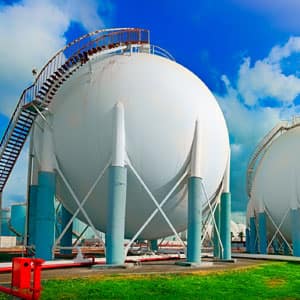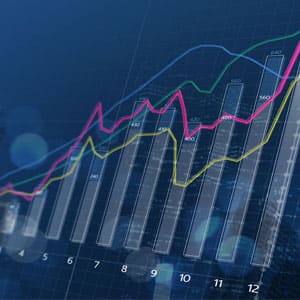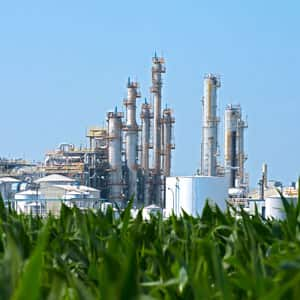- The Refinery of the Future: A dynamic investment outlook as multibillion-dollar green capex spend looms
-
When the world’s first oil refineries were constructed in the 1850s and 1860s, their primary raison d’être was the production of kerosene for use in oil lamps. The internal combustion engine was little more than a science experiment at the time so gasoline and diesel—or more accurately naphtha and gasoil—were effectively waste products for the world’s first refineries. Obviously, the world has changed dramatically since then, and the refining industry has changed right along with it.
However, the Energy Transition confronting the refining industry today is fundamentally different from any that came before. Because while the world has changed over the past 150 years, throughout it all, total oil product demand has continued inexorably upward. This assumption is no longer valid. S&P Global now expects that global refined product demand has little to no incremental growth “runway” beyond its pre-pandemic level. Alongside—and underpinning—the demand inflection point is a global reckoning for greenhouse gas emissions. Going forward, the carbon intensity of the world’s energy supply will no longer be ignored.
Obviously, an unavoidable outcome of these two trends will be refinery rationalization. Nearly 3 million b/d of refinery capacity has closed or has been slated for closure since the pandemic began, with at least another 1.5 million b/d expected to shutter by 2025. But the industry is by no means doomed to obsolescence. There are ways for a refinery to survive amidst declining gasoline and diesel consumption; to thrive even in a world that levies a price on every ton of carbon being emitted. But such reinvention unsurprisingly requires capital investment. This report details S&P Global’s first ever outlook for refinery decarbonization spending through 2050.
This is an abstract. The full deliverable is available for clients only.
- HollyFrontier acquires Sinclair: Gains scale, branded retail integration, and more renewable diesel
-
On 3 August, HollyFrontier announced that it will be acquiring fellow independent refiner Sinclair. Together with the previously announced purchase of Shell’s Anacortes refinery, the Sinclair deal will make HollyFrontier the country’s 10th largest refiner. The deal will also solidify HollyFrontier’s status as the preeminent refiner within the US Mid-Continent. However, greater economies of scale within the refining and supply arena were likely not the primary rationale for the acquisition. Instead, accretive benefits within the renewable fuels space and vertical integration down through branded retail may have been more salient motivators for HollyFrontier.
This report provides an overview of the deal, including implications for HollyFrontier and the broader competitive landscape.
This is an abstract. The full deliverable is available for clients only.
- Keeping us Warm this Winter: Oil to bridge the gap while natural gas price soars?
-
As natural gas prices climb higher, and with relief not forthcoming on the supply side, consumers are switching to cheaper alternatives. Besides a switch to coal, the oil complex has a role to play in providing an alternative to gas. S&P Global has assessed the potential upside to oil demand this winter at 0.6 MMb/d, comprising almost entirely refined products, with additional crude oil burn expected to be marginal and limited to consumption of sweet grades within some Japanese power stations.
- If all viable substitution mechanisms are activated simultaneously, the upside could rise further from 0.6 MMb/d to be closer to 0.8 MMb/d.
- That said, global oil demand is set to remain below pre-pandemic levels. Bearish risks remain as we enter winter and the specter of COVID-19–related containment reemerges.
- Refineries with exposure to current spot prices will reoptimize their operations and minimize natural gas intake to the extent possible, calling on incremental LPG and fuel oil for their energy needs.
- The winner from a price perspective would be crude oil, as this sizable demand upside may add to the structural stock draws. On the products side, LPG and fuel oil cracks will benefit most from this natural gas bull run.
This is an abstract. The full deliverable is available for clients only.
- Will Banning US Crude Oil Exports Lower Gasoline Prices? No—but it will disrupt the supply chain
-
On 8 November, 11 US Senators asked President Biden to “consider all tools available at your disposal to lower U.S. gasoline prices...[including] a ban on crude oil exports.” The letter from the senators was prompted by the 36% increase in US retail gasoline prices over the past year, which in October contributed to the highest US consumer inflation rate in 31 years. At a time when global supply chains are under exceptional strain, a US crude oil export ban would make a bad problem even worse—for US consumers and the world.
- A ban on US crude oil exports would set off a scramble for supply, driving up prices and raising further questions about the reliability of the United States as a partner
- The price of gasoline in the United States is connected to global oil and gasoline prices—and not the price of domestically produced crude oil.
- Most US crude oil exports are of light sweet crude oil grades, which cannot easily replace heavy sour crude oil imports run in many US refineries.
This is an abstract. The full deliverable is available for clients only.
- OPEC+: As the beginning of the end nears, what’s next?
-
OPEC+ production falling short of target levels remains a market focus, but there is a bigger question coming into focus. Will the OPEC+ supply restraint agreement end this year, as planned? If yes, what will follow?
- Most OPEC+ countries have exhausted their capacity to meaningfully increase oil supply for now, well ahead of a formal end to restraints scheduled for as early as September 2022.
- Absent the reemergence of an oversupplied market, OPEC+ now faces the prospect of negotiations to decide what cooperative structure, if any, its members can and should keep in place to manage supply as and when needed again.
- Russia is among those running out of spare capacity, at least for now. How might its priorities, and indeed its role as joint leader of the group change?
- Almost all of the group’s spare production capacity is now concentrated in two Middle East Gulf countries—Saudi Arabia, and to a smaller extent, the United Arab Emirates. What will be their oil price objectives, even if not openly stated, and what might they be willing to do to keep OPEC and OPEC+ intact?
This is an abstract. The full deliverable is available for clients only.
- Propane Winter Sensitivity: How weather outcomes can influence demand and prices
-
US propane inventory levels are relatively low as the country enters the winter demand season. Specifically, inventories are almost 21% below levels seen at the same time last year. Market tightness and participant woes have already pushed propane prices to levels last seen in early 2014, ahead of the winter heating demand season.
One “winter weather” anomaly would thus lead to higher prices into most of 2022. As such, S&P Global has developed three winter weather scenarios. The base case outlook assumes a normal winter season based on the heating degree days (HDDs) outlook from the National Oceanic and Atmospheric Administration (NOAA). A cold winter case reflects a 2013–14 winter—when a polar vortex across the United States resulted in much colder temperatures. A warm winter scenario assumes HDDs to be 10% less than the base case.
Under the cold winter case, propane inventory could drop to record low levels. Even in the base case, S&P Global expects US propane inventory to drop to about 40.5 MMbbl from the current level of around 74 MMbl. Meanwhile, in the base case, S&P Global expects propane prices at Mont Belvieu for November through March to average about 145 cpg. Average November 2021–March 2022 propane prices under the cold winter case could rise 10% above our base case outlook. Exports will play a critical role in balancing the markets and the demand from Asia, especially for the petrochemical sector, and will remain as another key determinant, along with colder or warmer temperatures, in driving propane prices higher or lower over the next four months.
This is an abstract. The full deliverable is available for clients only.
- The “Not-So-Majors”? Shell setting the pace for global major refinery rationalization
-
On 24 May, Shell made a somewhat surprising announcement: the company would be selling its 50% stake in the Deer Park (Texas) refinery. The fact that Shell is divesting a refinery is, in and of itself, hardly a surprise; the company has sold several refineries (and closed several more) in the past two years alone. Taking into account the Deer Park divestment and several other announced-but-not-completed portfolio edits, Shell now has a stake in just 12 refineries with a combined equity distillation capacity of 1.7 MMb/d. These numbers are down from a global portfolio of 50 refineries and an equity capacity of nearly 4.7 MMb/d as recently as 2007.
Of course, Shell is by no means the only titan of industry that has rationalized its refining portfolio—just the most aggressive to do so. The other four so-called ‘global majors’ have each cut between 25% and 47% of their equity distillation capacity since 2005. Collectively, they have sold or closed positions in nearly 60 refineries over that time.
However, spurred by a growing consensus that the world is truly nearing its peak oil demand—and increased investor appetite for companies to ‘go green’—the global major rationalization campaign appears to have entered a new, more serious, phase. Exactly where these efforts will take the global majors is unclear. But additional refinery closures or divestments are all but certain, with the complete disposition of a global major refining portfolio (be it a spin-off or several individual sales) an increasingly likely possibility.
This is an abstract. The full deliverable is available for clients only.
- The Price is Right: A perspective on automaker BEV pricing
-
The higher price of most battery electric vehicles (BEVs) compared with similar internal combustion engine (ICE) vehicles, together with a relative paucity of BEV models available for consumers to choose from, represents a barrier to greater BEV adoption. Yet this barrier will gradually crumble as automakers bring more—and more affordable—BEV models to market. This report offers a framework for comparing BEV and non-BEV prices by looking at the breadth of BEV models available to consumers across price points and vehicle size segments in three key markets.
- In mainland China and Germany, there are already BEV models available with prices that address a relatively large share of non-BEV volumes in key passenger car segments; in the United States, such coverage is less.
- Yet breadth of BEV model offerings will also be important in allowing BEVs to gain more market share. Currently, BEVs account for 20%, 8%, and 6% of all light vehicle (LV) models available to consumers in mainland China, the European Union, and the United States, respectively. S&P Global projects that these shares will rise to 31%, 39%, and 37%, respectively, in 2030, as automakers seek to meet stricter carbon dioxide (CO2) regulations.
- BEV price competitiveness will improve as the BEV-ICE powertrain cost gap narrows. Declining battery costs will be a key driver of this trend. Also, automakers, faced with pressures to comply with stricter environmental regulations and meet their own corporate environmental goals, may for a time need to accept lower profit margins on BEVs to incentivize consumers to choose them over ICE vehicles.
This is an abstract. The full deliverable is available for clients only.







